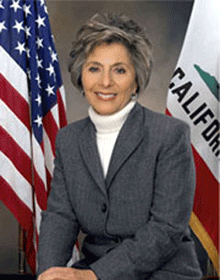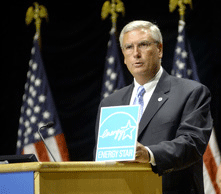EPA Takes Flack Over Soot
Air Date: Week of February 9, 2007

Senator Barbara Boxer, Chair of the Senate Committee on Environment and Public Works (Courtesy of the U.S. House of Representatives)
Critics say EPA won't pay for monitors that measure deadly particulate pollution and won't pay attention to the agency's own scientists who warn of health risks. Living on Earth's Jeff Young reports on the fallout from EPA's decisions on soot.
Transcript
CURWOOD: The regulation of fine particulates continues to bedevil the U.S. Environmental Protection Agency. Other air pollutants have decreased in recent years, but EPA records show that tiny particle pollution has gotten worse. And last year EPA Administrator Stephen Johnson touched off a controversy when he ignored his own science advisors on particulates. They had recommended a stricter health standard, tighter than the 15 micrograms per cubic meter that Dr. Pope just spoke about. Now, the EPA is under fire for changing the process those scientists use and cutting the budget for measuring tiny particulates. Living on Earth’s Jeff Young reports from Capitol Hill.
[SOUND OF MACHINES]
YOUNG: Near the center of Washington DC sits a white trailer with a roof full of
whirring metal machines keeping constant vigil on the capital’s air. Bill Becker’s biggest interest here, is the machine that measures the tiniest particles.
BECKER: The soot that is less than two and a half microns, um, which a fraction of the diameter of a piece of hair. It is very, very small.
YOUNG: Becker is with the National Association of Clean Air Agencies. He says monitors like this one alert people with breathing problems when the air is bad. And the monitors tell air officials when they need to do more to control fine particles.
BECKER: This is the foundation of every agency’s regulatory program. So without that data, agencies are at a loss for notifying the public and knowing whether or not the air is clean or not.
YOUNG: Becker says the Environmental Protection Agency’s budget would cut funds for
these monitors around the country by 17 million dollars- a 40 percent hit. Clean air advocates say the budget cuts are the latest in a string of troubling EPA decisions when it comes to fine particles: from not paying for the machines that gather raw data to not paying attention to the agency’s top science panel.
EPA’s clean air science advisers, a group known as CASAC, studied the mounting evidence linking fine particles to cardiovascular disease and premature deaths. The advisors recommended a stricter standard for fine particles last year, but EPA administrator Stephen Johnson rejected their recommendation. Then he changed the CASAC advisory process in a way that critics say limits the input of scientists. Now the new chair of the US Senate’s environment committee is taking Johnson to task.
BOXER: EPA’s actions make it clear who EPA is protecting, and sadly it is not the American people.

Senator Barbara Boxer, Chair of the Senate Committee on Environment and Public Works (Courtesy of the U.S. House of Representatives)
YOUNG: California Democrat Barbara Boxer called Johnson before her committee to
explain what she called "rollbacks" in environmental protection that favor polluters.
Johnson sat blinking in the witness chair like a man bracing for a blow. And true to her name, Boxer delivered. Her haymaker punch came with this description of Johnson’s changes to the agency’s scientific process.
BOXER: Instead of basing health standards on the best science they will now inject politics into the entire decision. Under EPA’s plan, key scientists will no longer work directly with top government officials to help set health standards. You took the science out of the clean air rule and stuck it at the end of the process. Nobody’s fooled by this. Here’s the point. These rollbacks were done in the dead of night. And it’s over, in terms of your not having to come before the committees of Congress to respond to them.
YOUNG: Johnson is the first career scientist to lead EPA, and he seemed stung as he
hurried from the hearing room. Reporters caught him waiting for an elevator, where he defended his changes to clean air science. Johnson says the science advisors simply take too long.
JOHNSON: There’s something wrong with the process. And that’s why I asked our deputy to initiate a top down look at the entire program.

EPA Administrator Stephen Johnson (Courtesy of the U.S. Department of Energy)
YOUNG: The science advisors of CASAC are supposed to update findings on major pollutants every five years. But Johnson says their cumbersome process means they rarely meet that deadline. He says his changes will allow the committee to work quickly while still considering a full range of views.
JOHNSON: And by the process that we’ve laid out, it very clearly defines, where the science input is and where the policy input is. I think this is much improved, we will have better and greater science influence at the same time being able to draw a very clear distinction between what is science and what is policy.
YOUNG: But many of the CASAC scientists disagree. The same morning Johnson squirmed in Boxer’s hot seat, the science advisors met to voice strong opposition to
Johnson’s changes. University of California medical professor, John Balmes, is a CASAC member. Balmes agrees the process should be streamlined. But he says Johnson went too far when he eliminated the step that lets scientists and EPA workers compile the most important science in a staff paper.
BALMES: The staff paper, or some other document that would be its equivalent, is vitally important and I believe that all of the CASAC members agree with me on that.
YOUNG: Balmes says the changes make EPA’s political appointees more powerful and
reduce science advisors to the same level as lobbying groups making comment. And Balmes says Johnson’s real motivation goes back to the disagreement over fine particles. The science advisors openly criticized Johnson for being the first EPA administrator to ignore their recommendations.
BALMES: The conflict between the- what the administrator wanted to do in terms of policy, and what the science shows,- was embarrassing to the administration. So if you get embarrassment, then just get rid of the staff paper. Then you won’t have to worry about embarrassment.
YOUNG: Some of the advisors say they are sending Johnson a letter protesting his
changes to the science process. And until the issue is settled it’s not clear how great a role science will play in setting EPA’s health standards. For Living on Earth, I’m Jeff Young in Washington DC.
Links
Living on Earth wants to hear from you!
Living on Earth
62 Calef Highway, Suite 212
Lee, NH 03861
Telephone: 617-287-4121
E-mail: comments@loe.org
Newsletter [Click here]
Donate to Living on Earth!
Living on Earth is an independent media program and relies entirely on contributions from listeners and institutions supporting public service. Please donate now to preserve an independent environmental voice.
NewsletterLiving on Earth offers a weekly delivery of the show's rundown to your mailbox. Sign up for our newsletter today!
 Sailors For The Sea: Be the change you want to sea.
Sailors For The Sea: Be the change you want to sea.
 The Grantham Foundation for the Protection of the Environment: Committed to protecting and improving the health of the global environment.
The Grantham Foundation for the Protection of the Environment: Committed to protecting and improving the health of the global environment.
 Contribute to Living on Earth and receive, as our gift to you, an archival print of one of Mark Seth Lender's extraordinary wildlife photographs. Follow the link to see Mark's current collection of photographs.
Contribute to Living on Earth and receive, as our gift to you, an archival print of one of Mark Seth Lender's extraordinary wildlife photographs. Follow the link to see Mark's current collection of photographs.
 Buy a signed copy of Mark Seth Lender's book Smeagull the Seagull & support Living on Earth
Buy a signed copy of Mark Seth Lender's book Smeagull the Seagull & support Living on Earth

